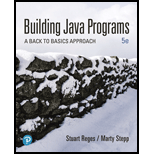
Concept explainers
Explanation of Solution
Program code:
Main.java:
//import the required packages
import java.io.File;
import java.io.FileNotFoundException;
import java.util.Scanner;
//define a class
public class Main
{
//declare the required variables
private static final double MONEY_QUARTER = 0.25;
private static final double MONEY_DIME = 0.10;
private static final double MONEY_NICKEL = 0.05;
private static final double MONEY_PENNY = 0.01;
//define a method countCoins()
public static double countCoins(Scanner input)
{
//declare the required variables
double totalAmount = 0.0;
int coinCount = 0;
String coinType;
//ierate a while loop
while (input.hasNext())
{
//get the tokens cointype and coincount
coinCount = input.nextInt();
coinType = input.next();
//if coin type is "QUARTERS"
if (coinType.equalsIgnoreCase("QUARTERS"))
{
//calculate the total amount
totalAmount += MONEY_QUARTER * coinCount;
}
//if coin type is "DIMES"
else if (coinType.equalsIgnoreCase("DIMES"))
{
//calculate the total amount
totalAmount += MONEY_DIME * coinCount;
}
//if coin type is "NICKELS"
else if (coinType.equalsIgnoreCase("NICKELS"))
{
//calculate the total amount
totalAmount += MONEY_NICKEL * coinCount;
}
//if coin type is "PENNIES"
else if (coinType.equalsIgnoreCase("PENNIES"))
{
//calculate the total amount
totalAmount += MONEY_PENNY * coinCount;
}
else
{
//print the coin type is wrong
System...
Want to see the full answer?
Check out a sample textbook solution
Chapter 6 Solutions
MyProgrammingLab with Pearson eText -- Access Code Card -- for Building Java Programs
- Could you help me to know features of the following concepts: - defragmenting. - dynamic disk. - hardware RAIDarrow_forwardwhat is a feature in the Windows Server Security Compliance Toolkit, thank you.arrow_forwardYou will write a program that allows the user to keep track of college locations and details about each location. To begin you will create a College python class that keeps track of the csollege's unique id number, name, address, phone number, maximum students, and average tuition cost. Once you have built the College class, you will write a program that stores College objects in a dictionary while using the College's unique id number as the key. The program should display a menu in this order that lets the user: 1) Add a new College 2) Look up a College 4) Delete an existing College 5) Change an existing College's name, address, phone number, maximum guests, and average tuition cost. 6) Exit the programarrow_forward
- Show all the workarrow_forwardShow all the workarrow_forward[5 marks] Give a recursive definition for the language anb2n where n = 1, 2, 3, ... over the alphabet Ó={a, b}. 2) [12 marks] Consider the following languages over the alphabet ={a ,b}, (i) The language of all words that begin and end an a (ii) The language where every a in a word is immediately followed by at least one b. (a) Express each as a Regular Expression (b) Draw an FA for each language (c) For Language (i), draw a TG using at most 3 states (d) For Language (ii), construct a CFG.arrow_forward
- Question 1 Generate a random sample of standard lognormal data (rlnorm()) for sample size n = 100. Construct histogram estimates of density for this sample using Sturges’ Rule, Scott’s Normal Reference Rule, and the FD Rule. Question 2 Construct a frequency polygon density estimate for the sample in Question 1, using bin width determined by Sturges’ Rule.arrow_forwardGenerate a random sample of standard lognormal data (rlnorm()) for sample size n = 100. Construct histogram estimates of density for this sample using Sturges’ Rule, Scott’s Normal Reference Rule, and the FD Rule.arrow_forwardCan I get help with this case please, thank youarrow_forward
 Database System ConceptsComputer ScienceISBN:9780078022159Author:Abraham Silberschatz Professor, Henry F. Korth, S. SudarshanPublisher:McGraw-Hill Education
Database System ConceptsComputer ScienceISBN:9780078022159Author:Abraham Silberschatz Professor, Henry F. Korth, S. SudarshanPublisher:McGraw-Hill Education Starting Out with Python (4th Edition)Computer ScienceISBN:9780134444321Author:Tony GaddisPublisher:PEARSON
Starting Out with Python (4th Edition)Computer ScienceISBN:9780134444321Author:Tony GaddisPublisher:PEARSON Digital Fundamentals (11th Edition)Computer ScienceISBN:9780132737968Author:Thomas L. FloydPublisher:PEARSON
Digital Fundamentals (11th Edition)Computer ScienceISBN:9780132737968Author:Thomas L. FloydPublisher:PEARSON C How to Program (8th Edition)Computer ScienceISBN:9780133976892Author:Paul J. Deitel, Harvey DeitelPublisher:PEARSON
C How to Program (8th Edition)Computer ScienceISBN:9780133976892Author:Paul J. Deitel, Harvey DeitelPublisher:PEARSON Database Systems: Design, Implementation, & Manag...Computer ScienceISBN:9781337627900Author:Carlos Coronel, Steven MorrisPublisher:Cengage Learning
Database Systems: Design, Implementation, & Manag...Computer ScienceISBN:9781337627900Author:Carlos Coronel, Steven MorrisPublisher:Cengage Learning Programmable Logic ControllersComputer ScienceISBN:9780073373843Author:Frank D. PetruzellaPublisher:McGraw-Hill Education
Programmable Logic ControllersComputer ScienceISBN:9780073373843Author:Frank D. PetruzellaPublisher:McGraw-Hill Education





